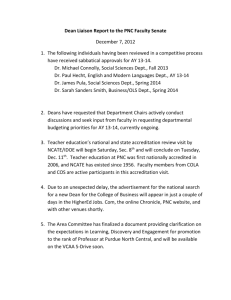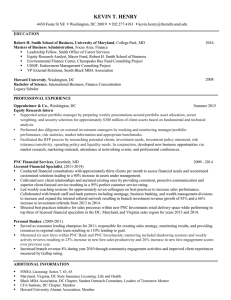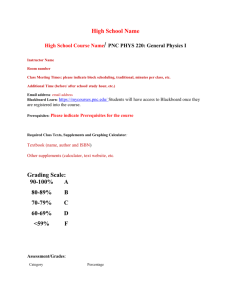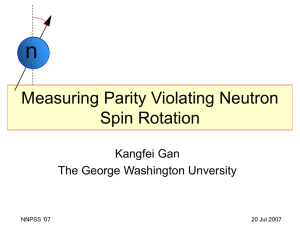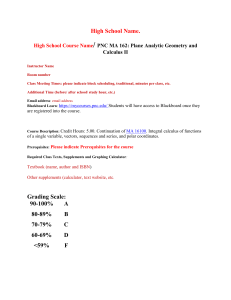Measuring the PNC Spin- Rotation of Polarized Neutrons Traversing Liquid Helium
advertisement
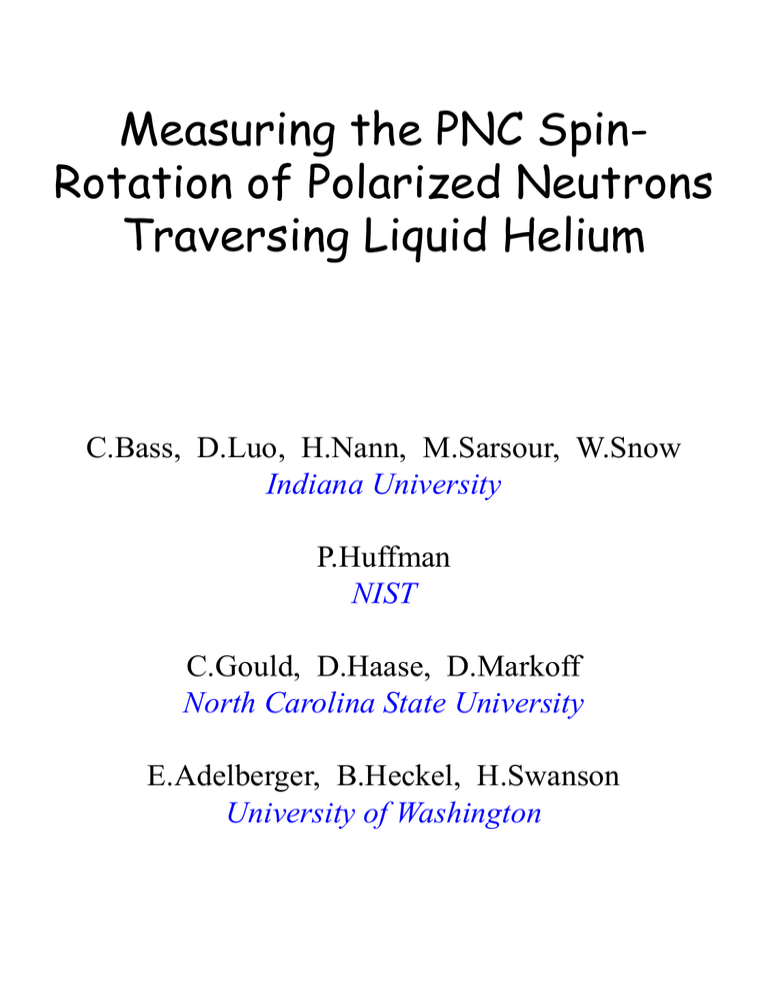
Measuring the PNC SpinRotation of Polarized Neutrons Traversing Liquid Helium C.Bass, D.Luo, H.Nann, M.Sarsour, W.Snow Indiana University P.Huffman NIST C.Gould, D.Haase, D.Markoff North Carolina State University E.Adelberger, B.Heckel, H.Swanson University of Washington Seminar Overview • Weak NN-Interaction and the MesonExchange Model • Spin-Rotation Observable • Experimental Apparatus • Project Status Nuclear Force: The Meson Exchange Model N N STRONG exchange STRONG mesons N N • separation distance < 0.8 fm: – repulsive core best described by spin-spin interaction between constituent quarks • separation distance > 2 fm: – one-meson exchange model yields excellent fit to data • intermediate separation distances: – various parameters need to be fitted by hand to both types of models Weak NN Interaction N N STRONG (PC) N exchange mesons WEAK (PNC) N • Z, W are massive (effective range 10-3 fm) • NN-interaction is strongly repulsive at short distances: – the low energy weak interaction is essentially pointlike – essentially no direct weak interaction at low energies • weak PNC potential characterized by weak meson exchange coupling constants – essentially all of the weak interaction physics is contained within the values of these coupling constants How Big is the Effect? q q W,Z aW q q N N aW aS N e2 m2 W,Z e 2 mW,Z gS2 aS 2 mπ p N 2 gS2 2 mπ ~ 10 7 Which Mesons? • At low energies, light mesons should dominate the PNC potential because of their longer ranges • possible scalar and pseudoscalar exchanges are limited by Barton’s theorem: – CP invariance forbids coupling between J=0 neutral mesons and on-shell nucleons • p6, r0, r6, and v0 exchanges dominate the low energy PNC potential • the weak meson exchange coupling constants: fp , hr0, hr1, hr2, hr19, hv0, hv1 Meson Exchange Coupling Constants • theoretical calculations of these coupling constants limited by uncertainties with quark model • 6 independent coupling constants require 6 independent experiments • the number of parameters can be reduced to 2 combinations of the couplings that dominate the observables: fp , and ( hr0 + 0.6 hv0). • experimental uncertainties are somewhat increased by allowing for variations of the four minor degrees of freedom: hr1, hr2, hv1 and residual in hv0 Weak meson-nucleon couplings constants hr 0 -0.38 g 0 -31 g 11.4 0 g 11.4 (DDH) range -9.5 -0.19 -11.4 4.6 (DDH) “best value” .308 -6.8 0.38 -8.4 1.1 (DZ) value -3.8 g -1.1 -10.6 g 2.7 -9.5 g -6.1 -1.1 g 0.4 -31 g 11 0 g 6.5 (FCDH) range -2.3 -4.9 -6.8 -0.4 -3.8 2.7 (FCDH) “best value” -2.3 -6.5 -6.8 -0.4 -6.1 2.7 (D) value -1.0 -3.8 -3.8 -0.02 -1.9 0.19 (KM) value -0.6 -4.9 -7.6 -0.2 -5.7 2.3 best fit -1.9 g -0.8 -10 g 5.7 -11 g -7.6 -0.4 g 0.0 -31 g 11 0 g 11 range Experimental hr 1 -11.0 g -7.6 -1.9 .-2.2 Theoretical hr 2 -10.3 g 5.7 -1.1 Coupling hv 0 -1.9 g 0.8 fp hv 1 Experimental Constraints on Weak Meson Exchange Constants Optical Spin-Rotation • polarized photons propagating through a “handed” medium undergo spin-rotation: Linear Polarization Medium with circular birefringence Circular Components Optical Rotation • cold neutrons propagating through spin-0 nuclei experience a similar rotation of the spin-polarization vector, but the “handedness” is the weak interaction Neutron Optics long-wavelength neutron scattering is mostly s-wave and isotropic: f ( ) f (0) coherent forward scattering amplitude for low-energy neutrons: f (0) A B n S N C n kn DS N kn E n (kn S N ) o kn is the neutron wave vector o S N is the target nuclei spin o n is the neutron spin index of refraction of a medium in terms of forward scattering amplitude: 2p n 1 2 r f (0) k the scattering potential contributes a phase to the neutron wave as it passes through a medium: Re(n )k0 z for k0 k0 zˆ 2p 1 2 r f 0 kn z k Neutrons Traveling Through Helium 4 He is spin-0 SN 0 so the coherent forward scattering amplitude becomes: f (0) A C n kn f PC f PNC ( n kn ) the contributed phase for neutrons passing through 4 He: 2p 1 2 r f PC f PNC ( n kn ) kn z k PC PNC 2pr PC 1 2 r f PC kn z PNC k 2p r z f PNC so, the accumulated phase differs for opposite helicity states kn Spin Rotation Observable start with a transversely polarized neutron beam: x 1 in the z-basis (beam direction) this is: x 1 1 2 2 opposite helicity states accumulate different phases: 1 iPC iPNC 1 iPC iPNC e e e e 2 2 the Parity NonConserving rotation of the angle of transverse spin is the accumulated phase difference: PNC 2PNC 4p r z f PNC Dmitriev et al. calculated the spin rotation of (n+a) based on the meson coupling constants (DDH): PNC (0.97 fp 0.22h0 0.22h1 0.32hr0 0.11h1r 0.02hr1 ) rad/m using DDH best values, PNC 0.1 1.5 10 6 rad/m Experiment Concept .B pn . pn PC + PNC l • cold neutrons are transversely polarized • neutrons travel through a helium target – PNC spin-rotation – PC spin-rotation • background B-field in target region • need to maximize PNC signal and minimize PC signal • neutrons enter the analyzer • goal of experiment: – Baxial = 0.5 Gauss [ MAG ~ 10 rad/m, – magnetic shielding [ Baxial < 100 mGauss – transmitted neutron flux contains information about the PC and PNC spin-rotation 6 2 3 10-7 rad/m sensitivity neutron beam polarizer (SM) guide tube pi-coil LHe cryostat rear target output coil inner mu-metal shield Experiment Overview outer mu-metal shield input coil analyzer (SM) neutron flux detector Neutron Beam • NG-6 beamline at NIST (Gaithersburg, MD) • energies in the 10-3 eV range (l ~ 5A) • beryllium filters provide high-energy cut-off – essentially 0% transmission below 3.4A – approx. 4% between 3.4A and 3.9A – about 90% above 3.9A 9.E+07 Neutron Flux (1996) 8.E+07 Flux ( n/cm^2/s ) 7.E+07 6.E+07 5.E+07 4.E+07 3.E+07 2.E+07 1.E+07 0.E+00 0 1 2 3 4 5 6 7 8 9 10 wavelength ( angstroms ) 11 12 13 14 15 Supermirror Polarizer and Analyzer • neutrons are polarized through spin-dependent scattering from magnetized mirrors • one spin-state is preferentially reflected by the mirror surface while the other state is transmitted and absorbed • designed to pass neutrons with the “up” spin state in the vertical direction • typical polarization: 98% 28 cm Neutron Beam Magnet Box Plate Curvature Radius ~ 10m Input Coil • spins precess about aligned vertical fields as the neutrons pass adiabatically through the input coil • neutrons reach a current sheet at the back of the coil and pass nonadiabatically into the field-free region main core mu-metal sheets for field shaping return core beam to LHe target inner shield outer shield current sheet Magnetic Shielding • mu-metal shielding surrounds the target region (including cryostat) • solenoidal coils inside shielding further reduces any residual axial B-fields p-coil y z beam direction x p-coil y y p - x x • a rectangular coil that produces a vertical magnetic field in the path of the beam • wound to prevent field leakage beyond the coil • designed so that the spin of a typical cold neutron will precess a total of p radians over the path of the coil Helium Target and Operation cold neutron beam TOP VIEW cold neutron beam Output Coil • neutron spins pass non-adiabatically through front of output coil • transverse component of spin adiabatically rotated into a horizontal B-field (y-axis) • the orientation of this (y-axis) B-field is flipped at a rate of ~ 1 Hz • spins then adiabatically rotated into the vertical (x-axis) direction of the analyzer • neutrons spins are now either parallel or antiparallel to the analyzer (depending on the target state and the orientation of the y-axis B-field) 3He Neutron Detector • neutrons detected through the following reaction: n 1 3He g 3H 1 1H • charged reaction-products ionize the gas mixture • high voltage and grounded charge-collecting plates produce a current proportional to the neutron flux Previous Version of Experiment (1996) • reached a sensitivity of ~2.6x10-6 rad/day of accumulated data • limited by statistics • systematic limits of the apparatus not reached PNC(n,a) 5 (8.0 6 14[stat] 6 2.2[syst]) 3 10-7 rad/m Redesign of Experiment • increase available statistics by improving reliability and decreasing downtime • increase the detected beam flux (NIST reactor upgrade: factor ~1.5) • use of superfluid helium • additional layer of mu-metal shielding • want a factor of x10 higher sensitivity in order to obtain a non-zero / null result: ~ 0.6310-6 rad / day of accumulated data estimate ~30 days of data for desired sensitivity New Target • use of superfluid helium (~1.7K) • non-magnetic and non-superconducting materials • new electrical feedthroughs (epoxy resin based) • liquid helium valve – lower temp requires additional refrigeration: 1K-Pot – superfluid leaktight – stainless steel won’t work back target pi-coil electrical feedthroughs front target LHe valve 1K-pot (evaporation refrigerator) (surrounding canister not shown for clarity) More Shielding • installation of 3rd layer of magnetic shielding: Cryoperm-10 • preliminary B-field mapping inside all three nested shields: – measured ~50 mGauss in target region without solenoidal coils – previous version designed for 100 mGauss background • want to further reduce this by 1/2 with trim coils Current Status • field mapping of in/output coils and magnetic shielding • analysis of systematic effects • computer simulations • new target ready for machining • machining of target components • run at NIST in fall 2003

